
15-12-2025 07:09
 Danny Newman
Danny Newman
indet. Rutstroemiaceae sp. on unk. fallen leavesMc

15-12-2025 21:11
 Hardware Tony
Hardware Tony
Small clavate hairs, negative croziers and IKI bb

15-12-2025 15:54
 Johan Boonefaes
Johan Boonefaes
Unknown anamorph found on the ground in coastal sa

15-12-2025 15:48
 Danny Newman
Danny Newman
Melanospora cf. lagenaria on old, rotting, fallen

15-12-2025 07:05
 Danny Newman
Danny Newman
Pseudosclerococcum golindoi (det: Zotto)near Cosb

15-12-2025 11:49
 Danny Newman
Danny Newman
ITS sequences from the following two collections B

15-12-2025 12:34
 Danny Newman
Danny Newman
indet. Rhytismataceae on oak leafnear Purchase Roa

09-12-2025 12:06
 Andgelo Mombert
Andgelo Mombert
Bonjour,Je recherche l'article concernant Hypobryo
Sur branches mortes de Salix en place (milieu humide à 830 m). Apothécies 1.5 – 2.5 mm de diamètre, cupuliforme, stipitée, l'hyménium jaune/vert, surface externe brune, asques octosporés, 135 – 210 x 11 – 14 µm, avec crochets, IKI-/KOH+MLZ-, spores lisses, d'abord hyalines, à maturité brunes, 11 – 15 x 7 – 8.5 µm, paraphyses septées, avec vacuoles réfringentes.
Je ne trouve pas d'espèce qui corresponde vraiment à ces caractéristiques. Qu'en pensez-vous ? Merci de votre avis.
Elisabeth





Elisabeth


Which image shows asci + IKI?
And which shows asci + MLZ with KOH pretreatment?
I would repeat the test.
It would be nice to see more images with multiple asci.
Greetings
Ingo
Elisabeth

MLZ stains brown.
Sorry, but nothing in your picture is brown.
Greetings
Ingo


Only now do I understand that there's another image hidden under "Velutarina-sp-MLZ-0001."
This image, "croziers+," and Zotto's explanation of the "thin apical wall" rule out rufo-olivacea.
Please excuse my misunderstanding.
Best regards
Ingo
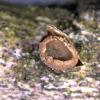

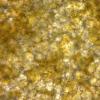
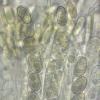
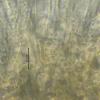

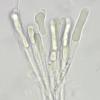
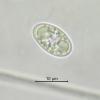
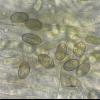
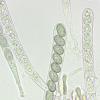
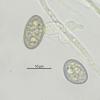

 Velutarina-sp.-MLZ-0001.jpg
Velutarina-sp.-MLZ-0001.jpg